fuel pressure GMC SAVANA 1997 Owners Manual
[x] Cancel search | Manufacturer: GMC, Model Year: 1997, Model line: SAVANA, Model: GMC SAVANA 1997Pages: 388, PDF Size: 20.17 MB
Page 7 of 388
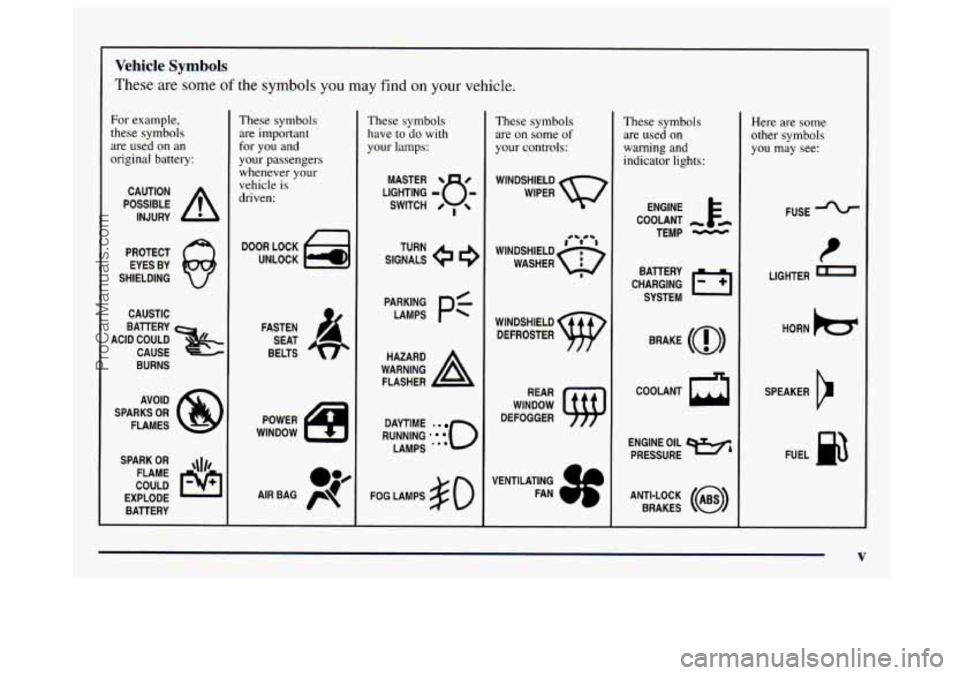
Vehicle Symbols
These are some of the symbols you may find on your vehicle.
For example,
these symbols are used on an
original battery:
POSSIBLE A
CAUTION
INJURY
PROTECT EYES BY
SHIELDING
CAUSTIC
ACID COULD BAlTERY
CAUSE
BURNS
AVOID
SPARKS
OR
FLAMES
SPARK
OR ,111,
COULD FLAME
EXPLODE BAllERY
These symbols are important
for you and
your passengers
whenever your
vehicle is
driven:
DOOR LOCK
UNLOCK
POWER
WINDOW
These symbols have
to do with
your lamps:
SIGNALS e e3
TURN
RUNNING
' *o
DAYTIME ..
LAMPS .*'
FOG LAMPS # 0
These symbols
are on some
of
your controls:
WINDSHIELD
WIPER
,
WINDSHIELD DEFROSTER
WINDOW
DEFOGGER
VENTILATING FAN
These symbols
are
used on
warning and
indicator lights:
COOLANT
TEMP
-
CHARGING BATTERY
SYSTEM
BRAKE
(a)
COOLANT
ENGINE OIL
PRESSURE
ANTI-LOCK
(@)
BRAKES
Here are some
other symbols
you may see:
FUSE
LIGHTER
m
HORN b
SPEAKER
b
FUEL e3
V
ProCarManuals.com
Page 120 of 388
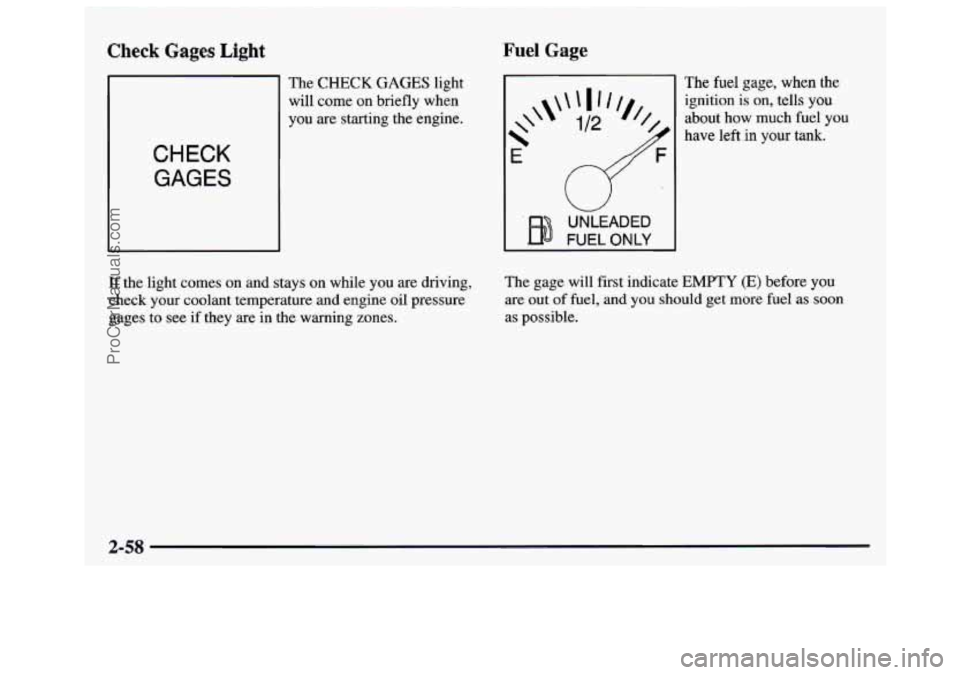
Check Gages Light Fuel Gage
CHECK GAGES
The CHECK GAGES light
will come on briefly when
you are starting the engine.
*
\\'
E-
UNLEADED
FUEL
ONLY
'
The fuel gage, when the
ignition is on, tells you
about how much fuel you
have
left in your tank.
If the light comes on and stays on while you are driving,
check your coolant temperature and engine
oil pressure
gages to see if they are in the warning zones. The gage
will first indicate EMPTY (E) before
you
are out
of fuel, and you should get more fuel as soon
as possible.
2-58
ProCarManuals.com
Page 175 of 388
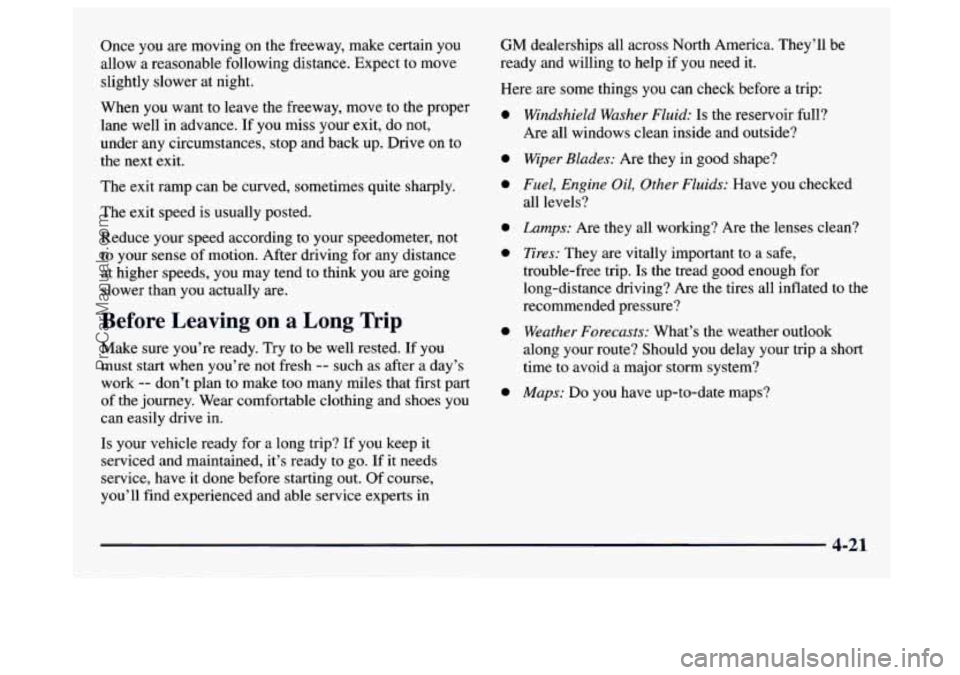
Once you are moving on the freeway, make certain you
allow
a reasonable following distance. Expect to move
slightly slower at night.
When you want to leave the freeway, move to the proper
lane well in advance. If you miss your exit, do not,
under any circumstances, stop and back up. Drive
on to
the next exit.
The exit ramp can be curved, sometimes quite sharply.
The exit speed is usually posted.
Reduce your speed according to your speedometer, not
to your sense
of motion. After driving for any distance
at higher speeds, you may tend to think you are going
slower than you actually are.
Before Leaving on a Long Trip
Make sure you’re ready. Try to be well rested. If you
must start when you’re not fresh
-- such as after a day’s
work
-- don’t plan to make too many miles that first part
of
the journey. Wear comfortable clothing and shoes you
can easily drive in.
Is your vehicle ready for
a long trip? If you keep it
serviced and maintained, it’s ready to go. If it needs
service, have it done before starting out. Of course,
you’ll find experienced and able service experts in GM
dealerships all across North America. They’ll be
ready and willing to help if you need it.
Here are some things you can check before a trip:
0
e
0
0
0
0
e
Windshield Washer Fluid: Is the reservoir full?
Are
all windows clean inside and outside?
Wiper Blades: Are they in good shape?
Fuel, Engine Oil, Other Fluids: Have you checked
all levels?
Lamps: Are they all working? Are the lenses clean?
Tires: They are vitally important to a safe,
trouble-free trip.
Is the tread good enough for
long-distance driving? Are the tires all inflated to the
recommended pressure?
Weather Forecasts: What’s the weather outlook
along your route? Should you delay your trip a short
time to avoid a major storm system?
Maps: Do you have up-to-date maps?
4-21
ProCarManuals.com
Page 181 of 388

Run your engine only as long as you must. This
saves fuel. When you
run the engine, make it go a
little faster than just idle. That is, push the accelerator
slightly. This uses less fuel for the heat that you get
and it keeps the battery (or batteries) charged.
You will
need a well-charged battery (or batteries) to restart the
vehicle, and possibly for signaling later on with your
headlamps. Let the heater run for awhile. If you have a
diesel engine you may have to
run it at a higher speed
to get enough heat.
Then, shut the engine off and close the window almost
all the way to preserve the heat. Start the engine again
and repeat this only when you feel really uncomfortable
from the cold. But do it as little as possible. Preserve
the
fuel as long as you can. To help keep warm, you can get
out of the vehicle and do some fairly vigorous exercises
every half hour or
so until help comes.
Loading Your Vehicle
COLD TIRE PRESSURE
L
The Certificatioflire label is found on the rear edge
of the driver’s door. The label shows the size of your
original tires and the inflation pressures needed to obtain
the gross weight capacity of your vehicle. This is called
GVWR (Gross Vehicle Weight Rating). The GVWR
includes the weight
of the vehicle, all occupants, fuel
and cargo.
4-27
ProCarManuals.com
Page 235 of 388
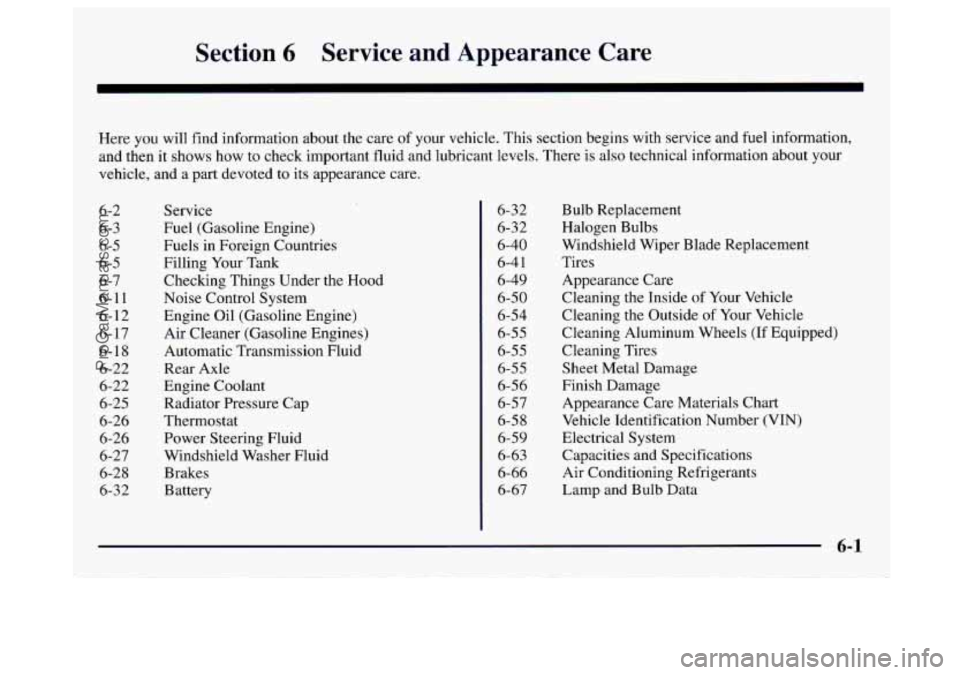
Section 6 Service and Appearance Care
Here you will find information about the care of your vehicle. This section begins with service and fuel information,
and then it shows how
to check important fluid and lubricant levels. There is also technical information about your
vehicle, and a part devoted to its appearance care.
6-2
6-3
6-5
6-5
6-7
6-1 1
6-12 6-17
6-18 6-22
6-22
6-25
6-26
6-26
6-27
6-28
6-32 Service
Fuel (Gasoline Engine)
Fuels in Foreign Countries
Filling Your Tank
Checking Things Under the
Hood
Noise Control System
Engine Oil (Gasoline Engine)
Air Cleaner (Gasoline Engines)
Automatic Transmission Fluid
Rear Axle
Engine Coolant Radiator Pressure Cap
Thermostat Power Steering Fluid
Windshield Washer Fluid Brakes
Battery 6-32
6-32
6-40
6-4
1
6-49
6-50
6-54
6-55
6-55 6-55
6-56
6-57
6-5
8
6-59
6-63
6-66
6-67 Bulb
Replacement
Halogen Bulbs
Windshield Wiper Blade Replacement
Tires
Appearance Care
Cleaning the Inside of Your Vehicle
Cleaning the Outside
of Your Vehicle
Cleaning Aluminum Wheels
(If Equipped)
Cleaning Tires Sheet Metal Damage
Finish Damage
Appearance Care Materials Chart
Vehicle Identification Number (VIN)
Electrical System
Capacities and Specifications
Air Conditioning Refrigerants
Lamp and Bulb Data
ProCarManuals.com
Page 276 of 388

Inflation -- Tire Pressure
The Certificationmire label, which is on the rear edge of
the driver’s door, shows the correct inflation pressures
for your tires when they’re cold.
“Cold” means your
vehicle has been sitting for at least three hours or driven
no more than
1 mile (1.6 km).
NOTICE:
Don’t let anyone tell you that underinflation or
overinflation is all right. It’s not.
If your tires
don’t have enough
air (underinflation), you can
get the following:
@ Too much flexing
Too much heat
Tire overloading
Bad wear
Bad handling
Bad fuel economy.
NOTICE: (Continued)
NOTICE: (Continued)
If your tires have too much air (overinflation),
you can get the following:
Unusual wear
Bad handling
Rough ride
Needless damage from road hazards.
I
When to Check
Check your tires once a month or more. Also, check the
tire pressure of the spare tire.
How to Check
Use a good quality pocket-type gage to check tire
pressure. You can’t tell if your tires are properly inflated
simply by looking at them. Radial tires may look
properly inflated even when they’re underinflated.
Be sure
to put the valve caps back on the valve stems.
They help prevent leaks by keeping out dirt and moisture.
6-42
ProCarManuals.com
Page 298 of 388
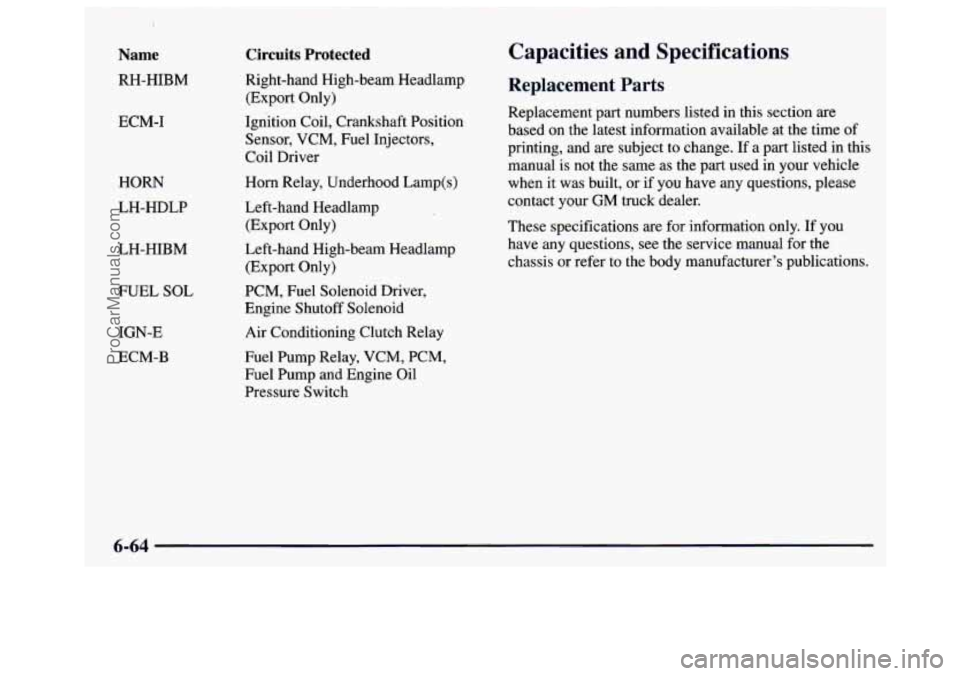
Name
RH-HIBM
ECM-I
HORN
LH-HDLP
LH-HIBM
FUEL SOL
IGN-E
ECM-B
Circuits Protected
Right-hand High-beam Headlamp
(Export Only)
Ignition Coil, Crankshaft Position Sensor, VCM, Fuel Injectors,
Coil Driver
Horn Relay, Underhood Lamp(
s)
Left-hand Headlamp
(Export Only)
Left-hand High-beam Headlamp
(Export Only)
PCM, Fuel Solenoid Driver,
Engine Shutoff Solenoid
Air Conditioning Clutch Relay
Fuel Pump Relay, VCM, PCM,
Fuel Pump and Engine Oil
Pressure Switch
Capacities and Specifications
Replacement Parts
Replacement part numbers listed in this section are
based on the latest information available at the time of
printing, and are subject to change. If a part listed in this
manual is not the same as the part used in your vehicle
when
it was built, or if you have any questions, please
contact your GM truck dealer.
These specifications
are for information only. If you
have
any questions, see the service manual for the
chassis or refer to the body manufacturer’s publications.
6-64
ProCarManuals.com
Page 349 of 388
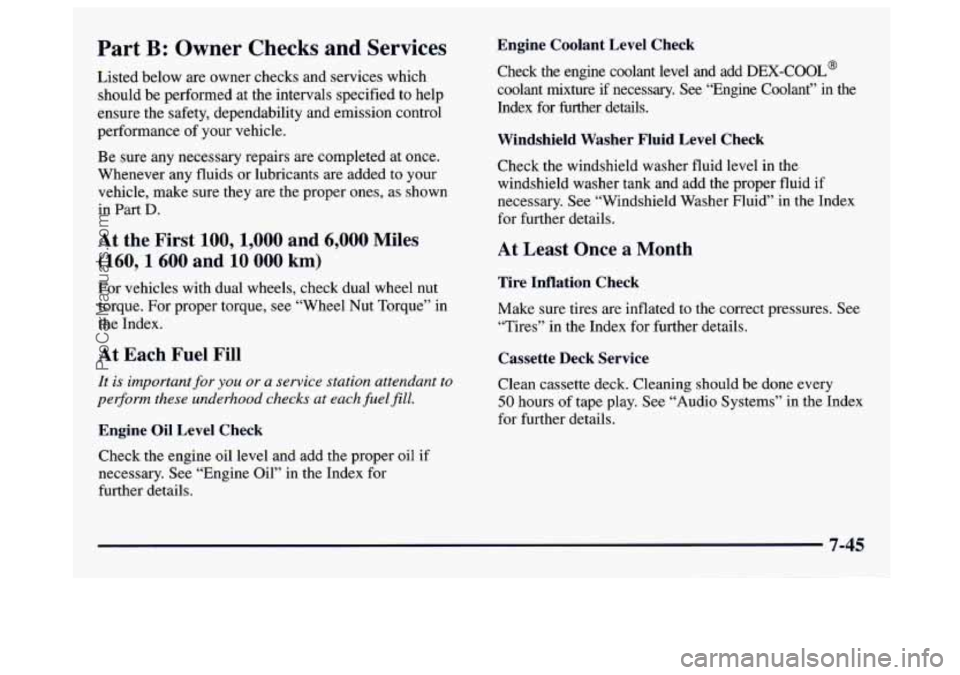
Part B: Owner Checks and Services
Listed below are owner checks and services which
should be performed at the intervals specified to help
ensure the safety, dependability and emission control
performance of your vehicle.
Be sure any necessary repairs are completed at once.
Whenever any fluids or lubricants are added to your
vehicle, make sure they are the proper ones, as shown
in Part
D.
At the First 100, 1,000 and 6,000 Miles
(160,1600 and 10
000 km)
For vehicles with dual wheels, check dual wheel nut
torque. For proper torque, see “Wheel Nut Torque” in
the Index.
At Each Fuel Fill
It is important for you or a service station attendant to
perform these underhood checks at each fuel
fill.
Engine Oil Level Check
Check the engine oil level and add the proper oil if
necessary. See “Engine
Oil” in the Index for
further details.
Engine Coolant Level Check
Check the engine coolant level and add DEX-COOL@
coolant mixture
if necessary. See “Engine Coolant” in the
Index for further details.
Windshield Washer Fluid Level Check
Check the windshield washer fluid level in the
windshield washer tank and add the proper fluid if
necessary. See “Windshield Washer Fluid’’ in the Index
for further details.
At Least Once a Month
Tire Inflation Check
Make sure tires are inflated to the correct pressures. See
“Tires” in the Index for further details.
Cassette Deck Service
Clean cassette deck. Cleaning should be done every
50 hours of tape play. See “Audio Systems’’ in the Index
for further details.
7-45
.~ ~
ProCarManuals.com
Page 378 of 388
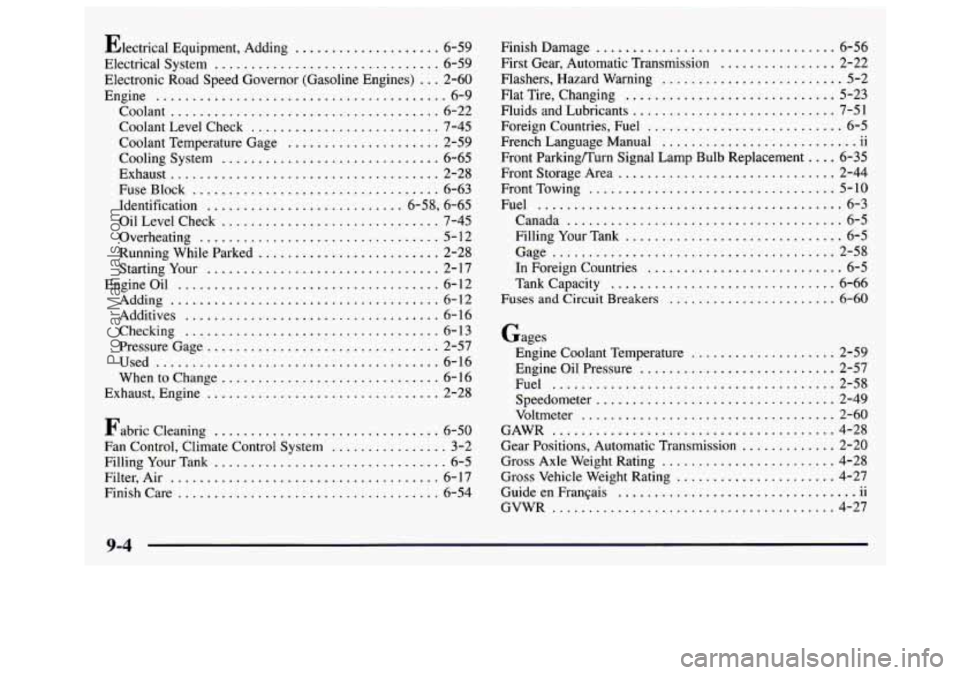
Electrical Equipment. Adding .................... 6-59
Electrical System ............................... 6-5.9
Electronic Road Speed Governor (Gasoline Engines) ... 2-60
Engine ........................................ 6-9
Coolant ..................................... 6-22
Coolant Level Check
.......................... 7-45
Coolant Temperature Gage
..................... 2-59
Cooling System
.............................. 6-65
Exhaust ..................................... 2-28
FuseBlock
.................................. 6-63
Identification ........................... 6.58. 6.65
OilLevelCheck .............................. 7-45
Overheating
................................. 5- 12
Running While Parked ......................... 2-28
Starting Your
................................ 2- 17
Engine Oil
.................................... 6-12
Adding ..................................... 6-12
Additives ................................... 6-16
Checking ................................... 6-13
Pressure Gage ................................ 2-57
Used
....................................... 6-16
Whentochange .............................. 6-16
Exhaust. Engine ................................ 2-28
Fabric Cleaning
............................... 6-50
Fan Control. Climate Control System ................ 3-2
FillingYourTank ................................ 6-5
Filter. Air ..................................... 6-17
Finish Care .................................... 6-54
Finish Damage ................................. 6-56
First Gear. Automatic Transmission ................ 2-22
Flashers. Hazard Warning
......................... 5-2
Flat Tire. Changing ............................. 5-23
Fluids and Lubricants
............................ 7-51
Foreign Countries. Fuel
........................... 6-5
French Language Manual 11
Front Parkingnurn Signal Lamp Bulb Replacement .... 6-35
Front Storage Area .............................. 2-44
FrontTowing
.................................. 5-10
Fuel .......................................... 6-3
Canada ...................................... 6-5
Filling Your Tank .............................. 6-5
Gage ....................................... 2-58
In Foreign Countries
........................... 6-5
Tankcapacity ............................... 6-66
Fuses and Circuit Breakers ....................... 6-60
.. ...........................
Gages Engine Coolant Temperature
.................... 2-59
Engine Oil Pressure ........................... 2-57
Fuel
....................................... 2-58
Speedometer ................................. 2-49
Voltmeter
................................... 2-60
Gear Positions. Automatic Transmission ............. 2-20
Gross Axle Weight Rating
........................ 4-28
Gross Vehicle Weight Rating
...................... 4-27
Guide en Franqais
11
GAWR ....................................... 4-28
.. .................................
GVWR ....................................... 4-27
9-4
ProCarManuals.com